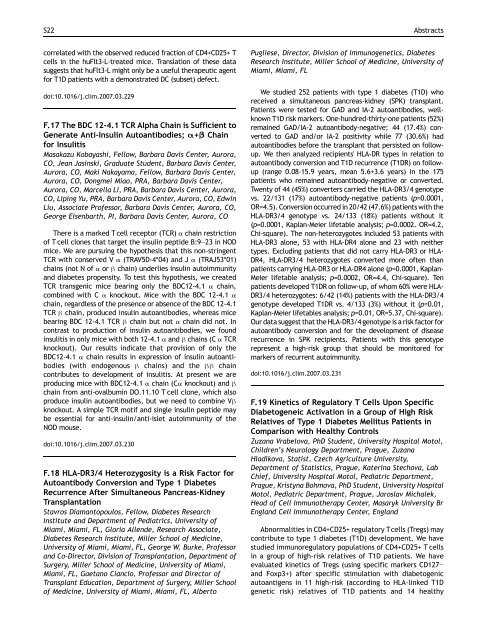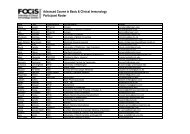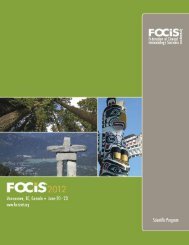Oral Presentations - Federation of Clinical Immunology Societies
Oral Presentations - Federation of Clinical Immunology Societies
Oral Presentations - Federation of Clinical Immunology Societies
You also want an ePaper? Increase the reach of your titles
YUMPU automatically turns print PDFs into web optimized ePapers that Google loves.
S22 Abstracts<br />
correlated with the observed reduced fraction <strong>of</strong> CD4+CD25+ T<br />
cells in the huFlt3-L-treated mice. Translation <strong>of</strong> these data<br />
suggests that huFlt3-L might only be a useful therapeutic agent<br />
for T1D patients with a demonstrated DC (subset) defect.<br />
doi:10.1016/j.clim.2007.03.229<br />
F.17 The BDC 12-4.1 TCR Alpha Chain is Sufficient to<br />
Generate Anti-Insulin Autoantibodies; α+β Chain<br />
for Insulitis<br />
Masakazu Kobayashi, Fellow, Barbara Davis Center, Aurora,<br />
CO, Jean Jasinski, Graduate Student, Barbara Davis Center,<br />
Aurora, CO, Maki Nakayama, Fellow, Barbara Davis Center,<br />
Aurora, CO, Dongmei Miao, PRA, Barbara Davis Center,<br />
Aurora, CO, Marcella Li, PRA, Barbara Davis Center, Aurora,<br />
CO, Liping Yu, PRA, Barbara Davis Center, Aurora, CO, Edwin<br />
Liu, Associate Pr<strong>of</strong>essor, Barbara Davis Center, Aurora, CO,<br />
George Eisenbarth, PI, Barbara Davis Center, Aurora, CO<br />
There is a marked T cell receptor (TCR) α chain restriction<br />
<strong>of</strong> T cell clones that target the insulin peptide B:9–23 in NOD<br />
mice. We are pursuing the hypothesis that this non-stringent<br />
TCR with conserved V α (TRAV5D-4*04) and J α (TRAJ53*01)<br />
chains (not N <strong>of</strong> α or β chain) underlies insulin autoimmunity<br />
and diabetes propensity. To test this hypothesis, we created<br />
TCR transgenic mice bearing only the BDC12-4.1 α chain,<br />
combined with C α knockout. Mice with the BDC 12-4.1 α<br />
chain, regardless <strong>of</strong> the presence or absence <strong>of</strong> the BDC 12-4.1<br />
TCR β chain, produced insulin autoantibodies, whereas mice<br />
bearing BDC 12-4.1 TCR β chain but not α chain did not. In<br />
contrast to production <strong>of</strong> insulin autoantibodies, we found<br />
insulitis in only mice with both 12-4.1 α and β chains (C α TCR<br />
knockout). Our results indicate that provision <strong>of</strong> only the<br />
BDC12-4.1 α chain results in expression <strong>of</strong> insulin autoantibodies<br />
(with endogenous β chains) and the ββ chain<br />
contributes to development <strong>of</strong> insulitis. At present we are<br />
producing mice with BDC12-4.1 α chain (Cα knockout) and β<br />
chain from anti-ovalbumin DO.11.10 T cell clone, which also<br />
produce insulin autoantibodies, but we need to combine Vβ<br />
knockout. A simple TCR motif and single insulin peptide may<br />
be essential for anti-insulin/anti-islet autoimmunity <strong>of</strong> the<br />
NOD mouse.<br />
doi:10.1016/j.clim.2007.03.230<br />
F.18 HLA-DR3/4 Heterozygosity is a Risk Factor for<br />
Autoantibody Conversion and Type 1 Diabetes<br />
Recurrence After Simultaneous Pancreas-Kidney<br />
Transplantation<br />
Stavros Diamantopoulos, Fellow, Diabetes Research<br />
Institute and Department <strong>of</strong> Pediatrics, University <strong>of</strong><br />
Miami, Miami, FL, Gloria Allende, Research Associate,<br />
Diabetes Research Institute, Miller School <strong>of</strong> Medicine,<br />
University <strong>of</strong> Miami, Miami, FL, George W. Burke, Pr<strong>of</strong>essor<br />
and Co-Director, Division <strong>of</strong> Transplantation, Department <strong>of</strong><br />
Surgery, Miller School <strong>of</strong> Medicine, University <strong>of</strong> Miami,<br />
Miami, FL, Gaetano Ciancio, Pr<strong>of</strong>essor and Director <strong>of</strong><br />
Transplant Education, Department <strong>of</strong> Surgery, Miller School<br />
<strong>of</strong> Medicine, University <strong>of</strong> Miami, Miami, FL, Alberto<br />
Pugliese, Director, Division <strong>of</strong> Immunogenetics, Diabetes<br />
Research Institute, Miller School <strong>of</strong> Medicine, University <strong>of</strong><br />
Miami, Miami, FL<br />
We studied 252 patients with type 1 diabetes (T1D) who<br />
received a simultaneous pancreas-kidney (SPK) transplant.<br />
Patients were tested for GAD and IA-2 autoantibodies, wellknown<br />
T1D risk markers. One-hundred-thirty-one patients (52%)<br />
remained GAD/IA-2 autoantibody-negative; 44 (17.4%) converted<br />
to GAD and/or IA-2 positivity while 77 (30.6%) had<br />
autoantibodies before the transplant that persisted on followup.<br />
We then analyzed recipients' HLA-DR types in relation to<br />
autoantibody conversion and T1D recurrence (T1DR) on followup<br />
(range 0.08-15.9 years, mean 5.6+3.6 years) in the 175<br />
patients who remained autoantibody-negative or converted.<br />
Twenty <strong>of</strong> 44 (45%) converters carried the HLA-DR3/4 genotype<br />
vs. 22/131 (17%) autoantibody-negative patients (p=0.0001,<br />
OR=4.5). Conversion occurred in 20/42 (47.6%) patients with the<br />
HLA-DR3/4 genotype vs. 24/133 (18%) patients without it<br />
(p=0.0001, Kaplan-Meier lifetable analysis; p=0.0002. OR=4.2,<br />
Chi-square). The non-heterozygotes included 53 patients with<br />
HLA-DR3 alone, 53 with HLA-DR4 alone and 23 with neither<br />
types. Excluding patients that did not carry HLA-DR3 or HLA-<br />
DR4, HLA-DR3/4 heterozygotes converted more <strong>of</strong>ten than<br />
patients carrying HLA-DR3 or HLA-DR4 alone (p=0.0001, Kaplan-<br />
Meier lifetable analysis; p=0.0002, OR=4.4, Chi-square). Ten<br />
patients developed T1DR on follow-up, <strong>of</strong> whom 60% were HLA-<br />
DR3/4 heterozygotes: 6/42 (14%) patients with the HLA-DR3/4<br />
genotype developed T1DR vs. 4/133 (3%) without it (p=0.01,<br />
Kaplan-Meier lifetables analysis; p=0.01, OR=5.37, Chi-square).<br />
Our data suggest that the HLA-DR3/4 genotype is a risk factor for<br />
autoantibody conversion and for the development <strong>of</strong> disease<br />
recurrence in SPK recipients. Patients with this genotype<br />
represent a high-risk group that should be monitored for<br />
markers <strong>of</strong> recurrent autoimmunity.<br />
doi:10.1016/j.clim.2007.03.231<br />
F.19 Kinetics <strong>of</strong> Regulatory T Cells Upon Specific<br />
Diabetogeneic Activation in a Group <strong>of</strong> High Risk<br />
Relatives <strong>of</strong> Type 1 Diabetes Mellitus Patients in<br />
Comparison with Healthy Controls<br />
Zuzana Vrabelova, PhD Student, University Hospital Motol,<br />
Children’s Neurology Department, Prague, Zuzana<br />
Hladikova, Statist, Czech Agriculture University,<br />
Department <strong>of</strong> Statistics, Prague, Katerina Stechova, Lab<br />
Chief, University Hospital Motol, Pediatric Department,<br />
Prague, Kristyna Bohmova, PhD Student, University Hospital<br />
Motol, Pediatric Department, Prague, Jaroslav Michalek,<br />
Head <strong>of</strong> Cell Immunotherapy Center, Masaryk University Br<br />
England Cell Immunotherapy Center, England<br />
Abnormalities in CD4+CD25+ regulatory Tcells (Tregs) may<br />
contribute to type 1 diabetes (T1D) development. We have<br />
studied immunoregulatory populations <strong>of</strong> CD4+CD25+ T cells<br />
in a group <strong>of</strong> high-risk relatives <strong>of</strong> T1D patients. We have<br />
evaluated kinetics <strong>of</strong> Tregs (using specific markers CD127−<br />
and Foxp3+) after specific stimulation with diabetogenic<br />
autoantigens in 11 high-risk (according to HLA-linked T1D<br />
genetic risk) relatives <strong>of</strong> T1D patients and 14 healthy




